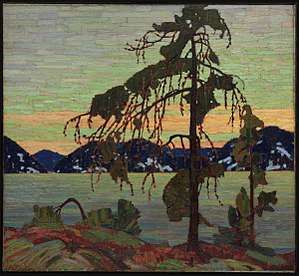Frank Johnston (artist)
Francis Hans Johnston (June 19, 1888 – July 19, 1949) was a Canadian artist associated with the Group of Seven.
Frank Johnston | |
|---|---|
 Frank Johnston, 1930 | |
| Born | Francis Hans Johnston June 19, 1888 |
| Died | July 19, 1949 (aged 61) |
| Nationality | canadian |
| Known for | painting |
Life and career
Frank Johnston (also known as Franz) was born on June 19, 1888 in Toronto, the son of Hugh Hans and Mary Elizabeth (Roderick) Johnston.[1][2] Like many other Group members, he joined Grip Ltd. as a commercial artist.[1] He studied in Germany from 1904 to 1907. Although his official association with the Group of Seven was short, his friendship with the artists dated back over a much longer period. In 1910, he left for the United States where he studied art in Philadelphia and worked in commercial design in New York. Although an original member of the Group, Johnston's association was brief. He did take part in the Group's first exhibition of 1920, but by 1921 he had left Toronto to become Principal at the Winnipeg School of Art.[3] In the earlier years of their friendship, Johnston had joined MacDonald and Harris on their journeys to Algoma. His paintings from those years express a strong decorative interpretation of the landscape. In later years, the artist's style became more realistic and revealed a strong fascination with the qualities of light. His landscape paintings became very full of images reflected on water. Johnston changed his name to the more exotic title of 'Franz' Johnston in 1925. He painted over 250 paintings in his entire career.
.jpg)
Johnston had much in common with these artists. Like them, in the years before World War I he used his spare time to pursue landscape painting, through sketching trips around Toronto and farther north to Bon Echo near Algonquin Park and to Hearst, north of Lake Superior—a source of inspiration for him. An eager participant in Group activities, Johnston went on all the Algoma trips except the last. Johnston did not use the techniques of Harris and MacDonald but, employing tempera rather than oil paint, he searched out the pattern and texture of his subject.[4]

Johnston exhibited with The Group of Seven only once, in their first show at the Art Gallery of Toronto (now the Art Gallery of Ontario) in May 1920. Johnston's rate of production was such that in the 1919 Algoma show he contributed sixty works - more than any other artist. A few months later, he extended his independence even more, having a large one-man show of 200 paintings at the T. Eaton Company Galleries. In the fall of 1921, Johnston left Toronto to accept the position as principal of the Winnipeg School of Art. There he held the largest show ever seen in that city. He had been slowly moving away from the Group movement, and now the break was complete. In 1924, he claimed that he had no disagreement with the group, only that he wanted to go his own way with regards to exhibitions.
When Johnston left The Group, he turned more to working for department store art galleries, concerning himself with decorative effects, which he constantly sought out.
Johnston's style became increasingly realistic throughout his life, evincing a particular fascination for the qualities of light reflected from snow. This theme recurred in later works, in large narrative paintings of the 1930s and 1940s as well as more intimate examinations of a river valley, the bright blue of the water bending between snow-laden banks. His subjects range from the pastoral countryside of the Wyebridge area, northern Quebec, and the Northwest Territories. He had begun in the 1920s to hold regular solo exhibitions and his paintings found a great following among the public. Unlike many Canadian artists, Johnston was able to achieve considerable financial success in his own lifetime.
He taught at the Ontario College of Art during the 1920s. In 1925, he changed his name to Franz Johnston.
He was made a member of the Royal Canadian Academy of Arts.[5]
He died in Toronto in 1949 and buried with his fellow artists at McMichael Canadian Art Collection in Kleinburg, Ontario.
References
- "Artist/Maker Name "Johnston, Francis Hans"". Canadian Heritage Information Network. Government of Canada. Retrieved 23 September 2015.
- Marilyn Baker; Gallery 111 (1984). The Winnipeg School of Art: The Early Years. Univ. of Manitoba Press. p. 44. ISBN 978-0-88755-613-5. Retrieved 22 January 2013.
- "Franz Johnston". National Gallery of Canada. Retrieved 23 September 2015.
- "Members since 1880". Royal Canadian Academy of Arts. Archived from the original on 26 May 2011. Retrieved 11 September 2013.
Further reading
- Boulet, Roger (1982), The Canadian Earth, M. Bernard Loates, Cerebrus Publishing, ISBN 0920016103
External links
| Wikimedia Commons has media related to Frank Johnston. |
- Works by Frank Johnston at Faded Page (Canada)
- A brief history of the Canadian Group of Seven
- Frank Johnston at Find a Grave
- CBC Digital Archives - The Group of Seven: Painters in the Wilderness
- Ontario Plaques - Franz Johnston
